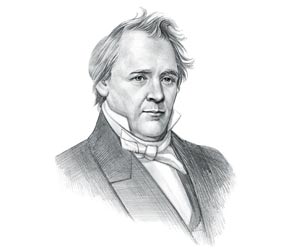|
The major accomplishments and the
famous, main events that occurred during the time that
James Buchanan was president included the establishment
of the short-lived Pony Express, the Panic of 1857 and
the Dred Scott Decision (1857). In 1859 John Brown
seized the Southern town of Harpers Ferry. Other main
events included the Crittenden Compromise (1860), the
Fort Sumpter Incident (1861). The 1860 Crittenden
Compromise failed and the Southern States begin
secession which led to the Civil War. James Buchanan
died on June 1, 1868 of respiratory failure, aged 77. The next president was
Abraham
Lincoln.
Birthday:
April 23, 1791
Place of Birth:
Pennsylvania
Political Party:
Democratic
Nickname:
Do-Nothing President
Number: 15th
President
Vice President:
John C. Breckinridge
Age at Inauguration:
65
Height: 6 feet
Weight: 198
pounds
First Lady:
Harriet Lane
Religion:
Presbyterian
Date of Death:
June 1, 1868
Date of James
Buchanan
Presidency: April 23, 1791 – June 1, 1868
The Nickname of James Buchanan: Do-Nothing President
The nickname of President James Buchanan provides an insight into
how the man was viewed by the American public during his presidency.
The meaning of the James Buchanan nickname "Do-Nothing President" refers to his
belief that secession was illegal and that the federal government
were unable to prevent states from seceding - thereby earning the
nickname 'The Do-Nothing President'. The meaning of his other
derogatory nickname "Ten-Cent Jimmy" is in reference to his
statement that ten cents a day was a fair wage for manual laborers.
Character and Personality Type of James Buchanan
The character traits of President James Buchanan can be described as
outgoing, genial, generous, dignified, loyal and highly principled. It has been speculated that the Myers-Briggs
personality type for James Buchanan is an ESTP (introversion, intuition,
thinking, perceiving). An outgoing, active, influential and
resourceful character with the ability to improvise to achieve
desired results. James Buchanan Personality type: Socially sophisticated,
persuasive, competitive and easily bored.
Accomplishments of James Buchanan and the Famous Events during his Presidency
The accomplishments of James Buchanan and the most famous events during his
presidency are provided in an interesting, short summary format
detailed below.
Panic of 1857
Summary of the Panic of 1857: The
Panic of 1857
was a
national depression that engulfed the country for nearly
three years.
It was triggered by the
collapse of a banking institution, the Cincinnati's Ohio Life
Insurance and Trust Company which together with a fall in
land prices, failures of railroad companies and falling wheat prices
led to the depression.
The Harris Treaty
Summary of the Harris Treaty: The
Treaty of Amity
and Commerce aka the Harris Treaty
was signed on July 29, 1858. It contained additional
provisions to the final Kanagawa Treaty, concentrating on trade and
commerce with Japan.
The Dred Scott Decision
Summary of the Dred Scott Decision: Dred Scott
was an African-American slave who attempted to sue for his freedom because he had been
taken by his owners to free states and territories.
The
Dred
Scott Decision
was a landmark decision by the Supreme Court in 1857
that ruled that slaves were property and also found that
Congress could not prohibit slavery from spreading into the western
territories.
John Brown’s Raid on Harper’s Ferry
Summary of John Brown’s Raid on Harper’s Ferry:
John Brown’s Raid on Harper’s Ferry,
on October 16, 1859, consisted of 21
men who were led by militant
anti-slavery activist John Brown who tried to seize ammunition from
an armory at Harpers Ferry with the intention of
equipping an army and leading a slave rebellion in the
south. John Brown was executed and proclaimed a martyr of the
anti-slavery cause. John Brown's Raid on
Harpers Ferry ultimately hastened the advent of the Civil War
and was one of the Causes of the Civil War
The Pony Express
Summary of the Pony Express: The legendary
Pony Express
was a mail service that covered
2000 miles in 10 days from Missouri to California.
The Pony Express began in
April 3, 1860
and ended in October 24, 1861. The Pony Express
was surprisingly only in operation for 18 months but the exploits of its
riders, such as William F. Cody, "Buffalo Bill",
live on in the legends of the
Wild
West.
Central Park
Summary of Central Park: The New York State
legislature initially acquired 778 acres of land and construction
work on
Central Park began in 1857
and was the first
landscaped public park in the United States.
The winners of the design contest for Central Park
were park superintendent, Frederick Law Olmsted and architect Calvert Vaux.
|

